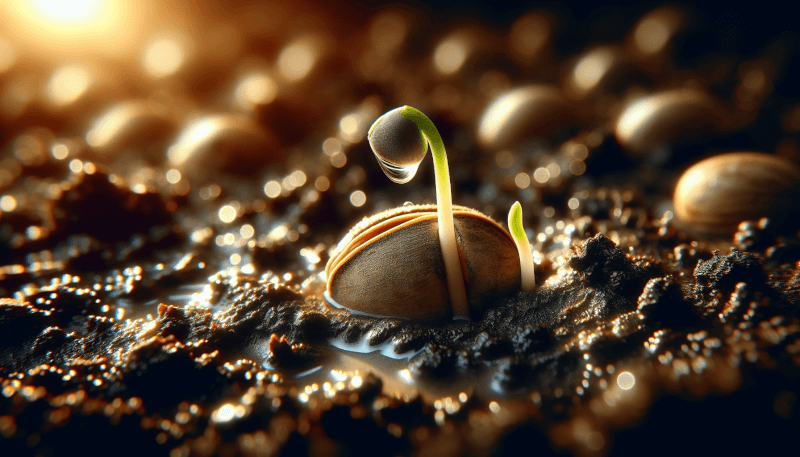Imagine the satisfaction of growing your own delicious and nutritious broccoli at home. The key to a successful harvest lies in the germination process of broccoli seeds. In this article, we will explore the fascinating world of broccoli seeds germination, uncovering the secrets to ensuring optimal growth and a bountiful yield. From the ideal planting conditions to helpful tips and tricks, get ready to embark on a journey that will not only satisfy your green thumb but also provide you with a fresh and healthy addition to your meals. Get ready to transform your garden into a thriving broccoli paradise.
Choosing Broccoli Seeds
When it comes to choosing broccoli seeds, there are a few factors to consider. First and foremost, think about the variety of broccoli you want to grow. There are different types of broccoli, each with its own unique flavor and texture. Some varieties are best suited for steaming, while others are great for stir-frying or even eating raw. Take some time to research the different varieties and choose one that suits your taste preferences and cooking needs.
In addition to variety, it is also important to look for organic and heirloom options. Organic seeds are grown without the use of synthetic pesticides or fertilizers, making them a healthier choice for you and the environment. Heirloom seeds, on the other hand, are from plants that have been passed down for generations, ensuring that you are growing a true and authentic variety. Both organic and heirloom seeds can usually be found at local nurseries or ordered online.
Lastly, check for seed quality. Look for seeds that are plump, firm, and have a uniform color. Avoid seeds that are discolored, shriveled, or damaged, as they may have lower viability and are less likely to germinate successfully.
Preparing the Seeds
Once you have chosen your broccoli seeds, it’s time to prepare them for germination. This step is crucial for ensuring successful seedlings and a healthy crop.
Start by soaking the seeds. This can help soften the seed coat and encourage faster germination. Simply place the seeds in a bowl of water and let them soak for about 12-24 hours. After soaking, drain the water and pat the seeds dry with a paper towel.
Next, add a seed starter mix to your chosen growing containers. A seed starter mix is lightweight and provides the ideal balance of moisture retention and drainage. Fill your containers with the mix, leaving about half an inch of space at the top.
Creating proper conditions for germination is also important. Broccoli seeds germinate best in temperatures between 60-70°F (15-21°C). You can use a heat mat or place your containers near a warm spot in your home to provide the optimal temperature. Additionally, cover the containers with a plastic dome or plastic wrap to maintain high humidity levels, which will help with the germination process.

Germination Process
During the germination process, there are a few key factors to consider to ensure successful seedling development.
Temperature requirements play a crucial role in the germination of broccoli seeds. As mentioned before, the ideal temperature range is between 60-70°F (15-21°C). If the temperature is too low, the seeds may not germinate, while if it is too high, the seeds may become dormant or even be damaged. It’s important to monitor and maintain a consistent temperature throughout the germination period.
Moisture and watering are also critical during germination. The seed starter mix should be kept consistently moist, but not waterlogged. Check the moisture level daily and water as needed, using a spray bottle or a gentle stream of water to avoid displacing the seeds.
Lighting conditions are essential for the seedlings’ growth. Broccoli seeds require adequate light to develop strong stems and leaves. Place your containers near a south-facing window or use artificial grow lights placed about 2-3 inches above the seedlings. Aim for about 12-16 hours of light per day for optimal growth.
Sowing Broccoli Seeds
When it’s time to sow your broccoli seeds, there are a few considerations to keep in mind.
Choosing the right location is crucial for successful cultivation. Broccoli plants thrive in full sun, so select a spot in your garden that receives at least six hours of direct sunlight per day. Ensure the area has good air circulation to minimize the risk of disease.
Preparing the soil is also important. Broccoli prefers well-draining soil that is rich in organic matter. Before sowing, amend the soil with compost or well-rotted manure to improve its fertility and structure.
There are different sowing methods you can choose from. One option is to sow the seeds directly into the ground. Make small holes, about 1/4 to 1/2 inch deep, and place one seed in each hole. Alternatively, you can start the seeds indoors and transplant them later. This method gives you more control over the growing conditions and allows for an earlier start if you live in a colder climate.

Caring for Germinating Seeds
To ensure healthy and robust seedlings, it’s important to provide the optimal care during the germination phase.
Maintaining optimal moisture levels is crucial for seedling development. Check the moisture level of the soil regularly and water as needed. Avoid overwatering, as it can lead to damping off and root rot, but also don’t let the soil dry out completely.
Protecting seedlings from pests and diseases is essential. Use organic pest control methods, such as applying neem oil or using insecticidal soap, to keep common pests like aphids and cabbage worms at bay. Monitor the seedlings regularly for any signs of disease or pests and take appropriate action if necessary.
Thinning the seedlings is a crucial step in caring for germinating seeds. Once the seedlings have established their first true leaves, carefully remove the weaker or overcrowded ones, leaving only the strongest and healthiest plants. This will allow the remaining seedlings to have sufficient space to grow and develop.
Transplanting Seedlings
When the seedlings have grown strong enough, it’s time to transplant them into their permanent growing location. Here’s what you need to know:
Determining the right time for transplantation is important. Wait until the seedlings have at least three to four true leaves and are about 4-6 inches tall. At this stage, they are mature enough to survive the transplanting process.
Preparing transplant containers is necessary. Use pots or containers that are at least 4 inches deep and have drainage holes at the bottom. Fill the containers with a well-draining potting mix, and water thoroughly before transplanting the seedlings.
Transplanting techniques involve gently removing the seedlings from their current containers or seed trays, taking care not to damage the delicate roots. Dig a hole in the new container or garden bed large enough to accommodate the root ball of the seedling. Place the seedling in the hole, fill in with soil, and gently firm it around the base. Water the seedlings after transplanting to help them settle in their new environment.
Providing Optimal Growing Conditions
To ensure the success of your broccoli plants, it’s important to provide them with optimal growing conditions throughout their lifecycle.
Proper spacing and air circulation are crucial for healthy plant development. Broccoli plants should be spaced about 18-24 inches apart to allow sufficient room for growth. This spacing also ensures good air circulation, which helps prevent the development of fungal diseases.
Fertilizer and nutrient requirements should be met for optimal growth. Broccoli plants are heavy feeders and require a nutrient-rich soil. Before planting, amend the soil with well-rotted compost or organic fertilizer. Additionally, side-dress the plants with a balanced organic fertilizer every 4-6 weeks during the growing season.
Managing temperature and sunlight is important for broccoli plants. They prefer cooler temperatures between 60-70°F (15-21°C). In hot climates, provide shade during the hottest part of the day to prevent heat stress. Adequate sunlight is still necessary, so ensure your plants receive at least 6-8 hours of direct sunlight daily.
Common Germination Problems
Despite your best efforts, sometimes problems can arise during the germination process. Here are a few common issues and how to address them:
Damping off is a fungal disease that can affect germinating seeds. To prevent damping off, ensure good air circulation, avoid overwatering, and use sterile seed starting mix. If you notice any signs of damping off, such as wilting or rotting seedlings, remove the affected plants immediately and adjust your watering practices.
Fungal infections can also occur during germination. To prevent fungal infections, avoid overcrowding the seedlings, maintain proper air circulation, and use sterile containers and tools. If any seedlings show signs of fungal infection, such as discolored or mushy leaves, remove them promptly to prevent the spread of the infection.
Leggy seedlings can be a result of inadequate light. If your seedlings are tall and spindly, it’s a sign that they are not receiving enough light. Adjust the lighting conditions by providing more direct light or moving the seedlings closer to a light source. Additionally, ensure that the temperature is within the optimal range, as high temperatures can also cause seedlings to become leggy.
Troubleshooting and Solutions
If you encounter any issues during the germination process, there are several troubleshooting strategies that can help:
Adjusting temperature and humidity levels can help solve many germination problems. Ensure that the temperature remains within the ideal range of 60-70°F (15-21°C) and that humidity levels are maintained. If necessary, use a seedling heat mat or a humidifier to create the proper conditions for seed germination.
Using natural pest control methods is an eco-friendly solution to combat pests. Employ techniques such as hand-picking insects, applying insecticidal soap or neem oil, or introducing beneficial insects like ladybugs or lacewings to your garden. These methods can help keep pests at bay without the use of harmful chemicals.
Supporting weak seedlings is essential to ensure their survival. If you notice any seedlings that are struggling, gently stake them to provide support. Use small stakes and soft ties to avoid damaging the delicate stems. Supporting weak seedlings will prevent them from falling over and allow them to grow and thrive.
Harvesting Broccoli
After all your hard work, it’s time to reap the rewards and harvest your broccoli. Here’s what you need to know:
Determining the right harvest time is important for flavorful and tender broccoli. Harvesting too early can result in underdeveloped heads, while harvesting too late can lead to tough and bitter florets. Look for firm, dark green heads that are approximately 4-7 inches in diameter. The buds should still be tight and compact.
Harvesting techniques involve cutting the main head of the broccoli plant. Use a sharp knife or garden shears to make a clean cut about 5 inches below the head. Leave the smaller side shoots intact, as they will continue to produce florets for several weeks.
Post-harvest care is important to prolong the freshness of your harvested broccoli. Rinse the heads under cool water to remove any dirt or debris. Pat them dry with a towel and store them in the refrigerator in a perforated plastic bag or wrapped in a damp paper towel. Freshly harvested broccoli can be stored for up to a week.
By following these tips and techniques, you can successfully grow and harvest your own broccoli from seed. Enjoy the satisfaction of producing your own fresh and nutritious vegetables right in your own backyard!
